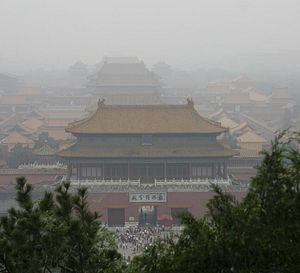The Chinese government has vowed to reduce air pollution for years. In 2013, the State Council even issued an “Air Pollution Prevention and Control Action Plan,” specifying detailed targets for air quality by 2017. However, as 2017 is coming to an end, the Chinese environmental protection minister, Li Ganjie, admitted recently that these targets may be hard to met.
From October 1 to 3, during China’s National Day holiday, Li visited Hebei, Shanxi, Shandong, and Henan — four heavily polluted provinces in northern China — to inspect the management of air quality control in local areas, according to a statement posted on the ministry’s website on October 4. During the visit the minister said:
The current air pollution control work challenging and grim. In this year, air quality has fluctuated, with some areas seeing a significant slowdown in improvement, and even a worsening. The completion of the annual targets for air quality control faces huge difficulties.
The targets Li mentioned here referred to those set by the State Council in the “Air Pollution Prevention and Control Action Plan.” The Plan, issued five years ago, demanded that by 2017, “the overall national air quality shall be improved. Heavily polluted days shall be reduced dramatically.” Specifically, “the urban concentration of Particulate Matters (PM10) shall decrease by 10 percent compared with 2012; Concentration of fine particulate matter (PM2.5) in Beijing-Tianjin-Hebei, Yangtze River Delta and Pearl River Delta region shall respectively fall by around 25 percent, 20 percent and 15 percent. Fine particulate matter annual concentration in Beijing shall be controlled below 60 micrograms per cubic meter. ”
However, in the first eight months of 2017, the air quality in China’s 338 largest cities on average deteriorated compared to 2016, with 78.3 percent of all days during the period experiencing clean air, down 2.8 percentage points from a year earlier, according to the ministry’s data.
In fact, Chinese experts and local officials have forecasted earlier than Li that these targets will very likely be missed. According to Global Times, China’s National Academy of Development and Strategy at Renmin University published a report in January, claiming that the majority of the Beijing-Tianjin-Hebei area won’t be able to fulfill the targets set in 2013. Wang Zhongxia, vice chief of environmental protection bureau in Handan (a highly polluted city in Hebei Province), said the task is so daunting that he couldn’t sleep for two nights after a related meeting.
In spite of this reality, China has been making a concerted effort to curb air pollution.
In September, the ministry launched a new policy in which it mandated that all governors of local districts or counties in the Beijing-Tianjin-Hebei area will be held responsible for the air quality. “No sloth in work or negligence is allowed. If you don’t work hard to implement your responsibility, you’d be held responsible,” said the ministry, without elaborating on details.
Ironically, Beijing’s then mayor Wang Anshun said in 2014 that he would present his own head to the public if Beijing’s smog couldn’t be controlled. His remarks were so widely reported in China that later some Chinese people called for his head when Beijing’s smog showed no trend of improvement. In response, Wang replied that it was a joke, but that it showed the weight of his resolution.
































